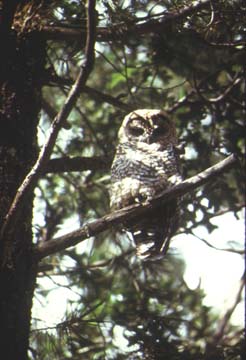Mexican Spotted Owl (Strix occidentalis lucida)

TPWD ©
- Other Names
- Spotted Owl
- Texas Status
- Threatened
- U.S. Status
- Threatened, Listed 3/16/1993
- Description
- Unlike most owls, Mexican spotted owls have dark eyes. They are an ashy-chestnut brown color with white and brown spots on their abdomen, back and head. Their brown tails are marked with thin white bands.
- Life History
- In Texas, Mexican spotted owls occur in the Guadalupe Mountains near the New Mexico border. The owls prefer the coolest part of the forest, often choosing nest trees on the northern or eastern-facing slopes. Nests on cliffs in Texas are at 5,000 to 7,000 feet elevation in deep, cool canyons. Most owlets (baby owls) leave the nest in June, about 35 days after hatching. Owlets are unable to fly very well when they first leave the nest, and their parents continue to feed them until they become fully independent, usually by October.
Woodrats, mice, pocket gophers, birds, and insects make up the Mexican spotted owl's diet. These owls hunt at night, moving from tree to tree, pausing to look and listen for prey. Their nests consist of stick platforms made by other birds, in tree cavities, and on cliff ledges, and they lay 1 to 3 eggs during March or April. In 1990, it was estimated that the Mexican spotted owl population for the southwestern United States was 2,160 birds, extremely rare and local in Texas. - Habitat
- They require mature, old-growth forests of white pine, Douglas fir, and ponderosa pine; steep slopes and canyons with rocky cliffs for their habitat.
- Distribution
- In Texas, the Mexican spotted owl occurs only in the mountains in the Davis and Guadalupe Mountains of west Texas.
- Other
- The Mexican spotted owl has declined because of habitat loss and alteration. Harvest of old-growth timber stands, even-aged timber harvest systems, and wildfires have contributed to loss of habitat. In Texas, Mexican spotted owls have been seen in or near Guadalupe Mountains National Park, and on TNC (private) property in the Davis Mountains of Jeff Davis County. They have never been found in any other mountain ranges in Texas.